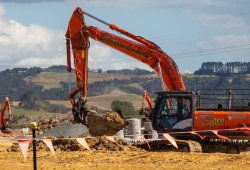Air quality improving in the Waikato region: report
4 September 2019
Air quality is improving in
the Waikato region, but indications are that Tokoroa is
unlikely to meet national environmental standards next
year.
That’s the finding of a report, Ambient Air Quality Monitoring Report for the Waikato Region – 2017, just released by Waikato Regional Council. The report provides an update on the state and trends of air quality at various urban locations around the Waikato region up to the end of 2017.
Senior regional council scientist Jonathan Caldwell said the main air pollutant of concern in the Waikato region is fine particulate matter.
“For health reasons we monitor the levels of particles that are small enough to be inhaled (PM10) and in some situations levels of PM2.5 which are even smaller sized particles able to penetrate deep into the lungs and enter the bloodstream,” Mr Caldwell said.
“The good news is that we’ve found improving trends for PM10 levels in Tokoroa, Taupō, Te Kūiti and Putaruru and that’s mainly due to the installation of efficient woodburners or other home heating appliances,” he said.
But despite further air quality monitoring up to mid-2019 also indicating continuous improvement, Tokoroa is unlikely to meet the National Environmental Standard for Air Quality (NESAQ) compliance target of no more than one exceedance per 12 month period by September 2020.
Monitoring of PM2.5 over the last three years in Tokoroa indicates that compliance with the World Health Organisation annual average PM2.5 guideline, if adopted as a national standard through the current review of the NESAQ, is also unlikely to be met.
Emissions from non-compliant fireplaces and the burning of wet wood have been identified as the greatest contributors to poor air quality in Tokoroa.
To address air quality in Tokoroa, the Warm Homes Clean Air project was established in 2007 by Waikato Regional Council and South Waikato District Council.
The partnership project has included both full and partial subsidies for replacement of non-compliant woodburners with clean heat installations such as NES-compliant burners or heat pumps, as well as education and awareness campaigns around burning dry wood and correct operation and maintenance of woodburners.
“Additional or alternative intervention is going to be needed to improve Tokoroa’s air quality,” Mr Caldwell said.
In response, an air quality education and
behaviour change plan has been developed by the regional
council with the following objectives:
• Grow
education, awareness and behaviour change around best
practices for burning.
• Increase uptake of clean heat
replacement incentive schemes offered by the
councils.
• Facilitate community-led action for
improving air quality.
• Understand the communities’
perspectives around community-led action for improving air
quality.
• Explore, research and develop synergistic
opportunities with other government agencies and regional
partners.
The regional council has begun further engagement with key stakeholders and a shared vision to improve air quality has been established. The regional council will work alongside key stakeholders, including the community, to achieve these objectives.
The report can be found at: www.waikatoregion.govt.nz/tr201815.
ends


 Gordon Campbell: On When Racism Comes Disguised As Anti-racism
Gordon Campbell: On When Racism Comes Disguised As Anti-racism Labour Party: Public Transport Costs To Double As National Looks At Unaffordable Roading Project Instead
Labour Party: Public Transport Costs To Double As National Looks At Unaffordable Roading Project Instead The Treasury: New Paper On A Framework For Assessing The Economic And Fiscal Impacts Of Climate Change
The Treasury: New Paper On A Framework For Assessing The Economic And Fiscal Impacts Of Climate Change Government: Pet Bonds A Win/Win For Renters And Landlords
Government: Pet Bonds A Win/Win For Renters And Landlords Government: New Zealand Condemns Iranian Strikes
Government: New Zealand Condemns Iranian Strikes Environmental Defence Society: Calls For Fast-track Approvals Bill To Be Abandoned In Submission To Select Committee
Environmental Defence Society: Calls For Fast-track Approvals Bill To Be Abandoned In Submission To Select Committee Government: Roads Of National Significance Planning Underway
Government: Roads Of National Significance Planning Underway


